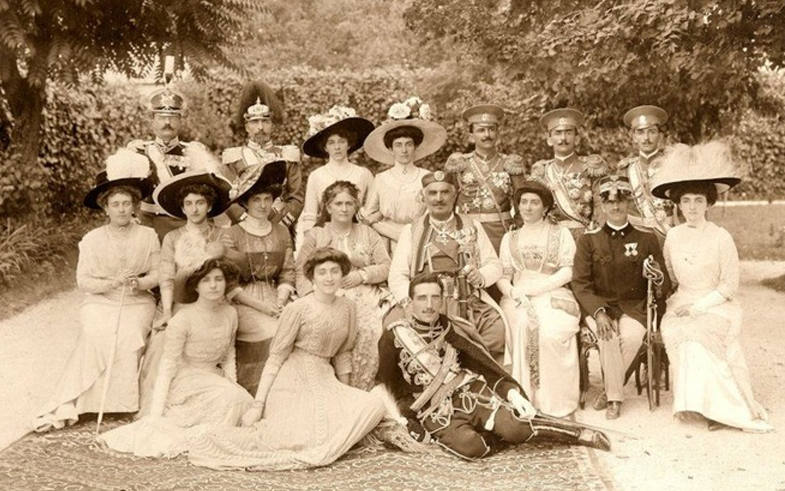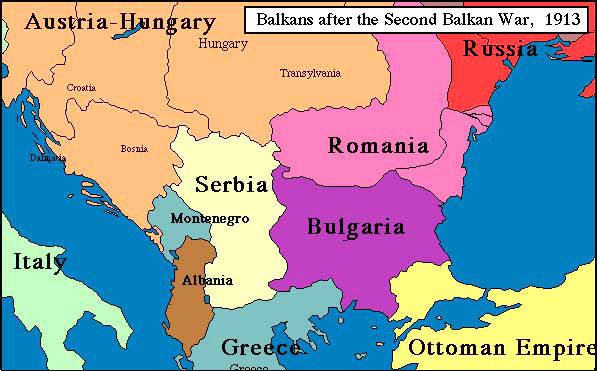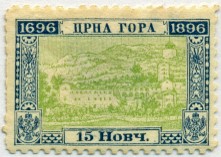ALBUM – View my Montenegro Album
Fast Facts
Region: Balkans
Group: Yugoslav Area
Classification: Principality / Kingdom
Prior Regime: Nominal Ottoman control
Key Dates:
1852 – Montenegro became a Principality under Danilo..
1860 – Nikola became Prince after his uncle Danilo was assassinated.
1878 – Principality of Montenegro recognized as an independent state
1905 – Constitution instituted in Montenegro
1910 – Prince Nikola elevated to King
1912-13 – First Balkan War
1914, Aug – Montenegro joins World War I
1916 – Montenegro surrenders to the Austrians
Following Regime: Austrian Occupation of Montenegro in WW1
Scott Catalogue: (Montenegro) #1-110, J1-J26, H1-H5
Pick Catalogue: (Montenegro, Kingdom) #1-21
History

Montenegro (black mountain) is a mountainous realm in the Balkan region which had been under the nominal rule of the Ottoman Empire since 1528. In 1690 it was granted the status of Prince-Bishopic under the Orthodox church, and Danilo I was appointed Metropolitan and Petrović Njegoš (Prince Bishop). More than a century and a half later, in 1851, at the death Prince Bishop Petar II, Danilo II, his nephew assumed the title after a brief political struggle. Danilo II decided that he wanted marry, so after receiving an endorsement from Czar Nicholas I of Russia, Montenegro abolished the centuries of ecclesiastical rule becoming a secular Principality with Danilo II as it’s Prince.
On Aug 13, 1860, Danilo was assassinated by a rival clan, and his nephew, Nikola became Prince. Shortly after taking power, 19-year-old Nikola married Milena, the 13-year-old daughter of a important Montenegrin General. The marriage was political, and the young Princess consort had a difficult time adjusting to her new responsibilities. In 1865, Milena gave birth to the first of her twelve children. After having four daughters in quick succession, the heir to the throne, Prince Danilo was born in 1871.
During his reign, Prince Nikola led many skirmishes against the Ottomans, however in 1875, a full scale rebellion broke out against Ottoman control in neighboring Bosnia and Herzegovina. Montenegro and Serbia joined the insurgency which spread across the region, resulting in the Russo-Turkish War of 1877-78.
Following the defeat of the Ottomans, the subsequent treaty of Berlin in 1878 completely re-balanced the power structure in the Balkan region. Bulgaria was established as an independent principality inside the Ottoman Empire and Eastern Rumelia and Macedonia were returned to the Ottomans. Romania, Serbia and Montenegro obtained independence, Britain took over Cyprus, and Bosnia and Herzegovina was assigned to the become a protectorate of Austria-Hungry while technically remaining under Ottoman sovereignty.
Prince Nikola ruled Montenegro like a petty tyrant, running the country like his private country club. There was no distinction between his private wealth and that of the country, he neglected education and had little concern about bettering the lives of the Montenegrin people.
Eventually, in 1905, Prince Nikola reluctantly agreed to institute a constitution, allowing elections and creating a National Assembly. This began a decade of monumental change for the small country and the surrounding region. On 6 Oct, 1908, Austrian Emperor Franz Joseph, announced his intention to fully annex Bosnia-Herzegovina, into the Austro-Hungarian Empire. This created great angst among various powers across Europe, leading most historians believe that this annexation ultimately set off the events which lead to World War I five years later.
In 1910, fifty years after becoming prince, Nikola elevated himself as King and began working towards improving relations with Serbia. Two years later, Montenegro joined with Serbia, Greece and Bulgaria to form the Balkan League and fought the Ottomans in 1912, in the first Balkan War. The outcome of the war expelled the Ottomans from most of Europe, allowing the victors to divide up its conquests. As a result, Montenegro significantly expanded its territory, however the border with Serbia was left open as discussions of a Serbian-Montenegrin union gained traction.
All talks of unification were cut short with the start of World War I. In July 1914, Austria declared war on Serbia, and Montenegro, in support, declared war on Austria and Germany in August. The much stronger Austrian army defeated Serbia in Oct 1915 prompting Montenegro to attempt to sue for peace even while Serbian soldiers were fighting on Montenegrin soil. This was considered a great betrayal by the Serbians, and within the Allies. In January, 1916, the Austrians took the Montenegrin Capital, Cetinje and King Nikolan and his small entourage fled to Italy.
King Nikola attempted to gain support from the Allies, but he had essentially lost all prestige among the allies. After the war, Montenegro became a part of the newly formed Kingdom of Serbs, Croats and Slovenes, later being named Yugoslavia.

Stamps
 ALBUM
ALBUM
First Prince Nikola Design – The first stamps of Montenegro where issued in 1874 in conjunction with the opening of the first post office for public use in Cetinje. The stamps featured the portrait of Prince Nikola, a design which would be used for more than 25 years. This first set was issued in seven denominations (2n, 3n, 5n, 7n, 10n, 15n and 25n). Montenegro used currency of the Austro-Hungarian Empire. 100 Novcic = 1 Florin (Gulden)
Two additional printings of the Prince Nicola stamps were issued each with minor differences in perforation. The Middle Printing in 1879 and the late in 1893. The additional printings can be distinguished in minor variations of perforation.
In 1893 the Prince Nikola stamps were stamps were overprinted in red or black to commemorate the 400th Anniversary of introduction of printing into Montenegro.
In 1894, Montenegro issued an additional six denominations to the Prince Nikola stamp set (1n, 20n, 30, 50n, 1F and 2F).
In 1898, the original set if Prince Nikola stamps (2n, 3n, 5n, 7n, 10n, 15n and 25n) were reissued in different colors.
Cetinje Monastery design – On Sep 1st, 1896, Montenegro issued a beautiful set of 12 stamps featuring the Cetinje Monastery. The stamps were issued to commemorate the 200th anniversary of the ruling dynasty founded by Danilo I, elected as the Metropolitan and Prince Bishop of Cetinje in 1696.
Prince Nikola new designs – On July 2nd, 1902, a new stamp design featuring an older Prince Nikola was issued in the new Austrian currency: 100 Heller = 1 Krona. Nine denominations were issued.
1905 Constitution overprints – On Dec 5, 1905, the Prince Nikola stamps were overprinted in red or black to commemorate the ratification of the new Montenegrin constitution. Various overprint sizes and spacing’s were printed.
Prince Nikola in a hat design – On July 4, 1907, Montenegro issued a new set of stamps featuring Prince Nickola wearing the Montenegro national hat. Twelve denominations were issued. In 1906, Montenegro introduced its own currency: 100 Para = 1 Perper and began minting coinage. The lower denomination stamps were issued in Para, but the three higher denominations continued to be issued in Krona. The Perper was pegged to the Krona 1:1.
Coronation Stamps – On Aug 28th, 1910, Montenegro released a beautiful set of stamps to celebrate the 50th anniversary of the reign of Nikola as well as his elevation from Prince to King. The stamps feature depictions of King Nikola at various ages. The set also commemorated the golden anniversary of the marriage of Nikola and Milena.
King Nicholas Designs – On Apr 1st, 1913, a new set of King Nicholas stamps were issued in twelve denominations. This stamp was issued during the first Balkan war.
Postage Due Stamps – Various sets of postage due stamps were issued in 1893, 1902, 1905 (constitution overprints), and 1913.
Acknowledgement of Receipt Stamps – Montenegro also issued Acknowledgement-of-Receipt stamps which required the recipient to sign a receipt as proof of delivery. In most countries payment for this service was indicated by stamping the letters “A.R.” (conveniently, the abbreviation is appropriate in English, French and Spanish). Montenegro is the only country outside of Latin America to issue acknowledgement-of-receipt stamps.
Banknotes
Prior to 1906, Montenegro used the currency and banknotes of Austro-Hungarian Empire until it officially changed it currency to the Perper: 100 Para = 1 Perper. One Perper was equivalent to one Austrian Krona. Montenegro began minting coins in 1906, and it wasn’t until 1912 that Banknotes were introduced.
Montenegro’s first banknotes were issued in denominations of 1, 2, 5, 10, 50 and 100 perpera. In 1914, the government issued another two series on notes in the same denominations. During the Austrian occupation during World War I, government notes of the second and third series were hand stamped for validation by the military government command centers.
Links
The History of Montenegro from Wikipedia
Montenegro Stamps at BigBlue 1840-1940
Stamps of Montenegro: The 1910 Coronation Issue
Montenegro Banknotes from ATS Notes




